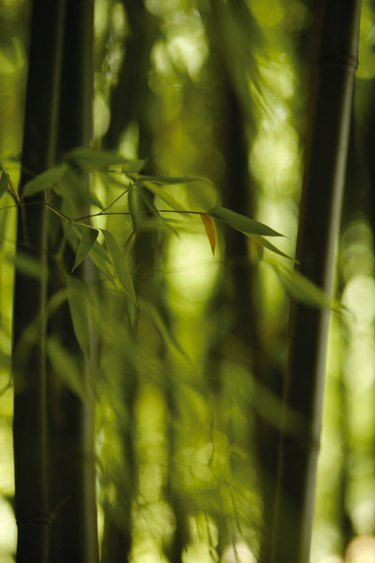
Native to China, Bisset's bamboo (Phyllostachys bissetii) entered the United States in the 1940s through the plant-collecting and evaluation efforts of David Bisset in Savannah, Georgia. Like other running bamboos in the genus Phyllostachys, Bisset's bamboo grows vigorously and quickly when given optimal conditions. Among the most cold-hardy of bamboos, surviving winters that drop into the -10 to -20 degree Fahrenheit range, this dense bamboo is appropriate to grow in U.S. Department of Agriculture plant hardiness zones 5 through 10.
Spread Potential
Video of the Day
Bisset's bamboo is considered by horticulturists as a leptomorph bamboo: the underground rhizomes tend to grow horizontally with long nodes. This is the reason that leptomorph bamboos spread quickly, not maintaining a tight clumping habit, but a spreading thicket of stems. Leptomorph rhizomes in the Phyllostachys genus also grow close to the soil surface. Bisset's bamboo, on average, can spread 2 to 4 feet outward annually. This means a plant clump of stems or culms 3 feet wide in year one can become 7 to 11 feet wide by the end of the second year.
Video of the Day
Growth Rate
Expect Bisset's bamboo to spread and grow much more quickly when in an ideal landscape setting. A fertile, organic-rich soil that is crumbly in texture promotes faster spreading and reach of the leptomorph rhizomes compared to a dense, compacted soil with diminished nutrients. Likewise, bamboos grow less voraciously if the soil is too dry or becomes flooded. The latter condition leads to plant death faster than a bout with a seasonal drought. In regions with milder winters and longer, warmer summer growing seasons, you'll experience faster growth on Bisset's bamboo. Evenly moist, well-drained soil and a full-sun garden exposure leads to the fastest growth. Dense shade also slows growth.
Limiting Spread
Luckily for gardeners, Bisset's bamboo's rhizomes grow within the top 10 inches of soil, making them rather easy to uncover by digging. Chopping off spreading rhizomes is one way to limit this bamboo's spread, but it is an ongoing maintenance task from spring to fall. Thick concrete barriers, such as a driveway or foundation, or PVC liners can limit the bamboo's spread as long as there are no holes or wide cracks. Newly emerging shoots may also be cut or chopped off in spring and summer. Limiting the number of new culms lowers the amount of photosynthesis, helping slow growth. Cutting the shoots off, when less than 2 feet tall, is easy with a sharp shovel or lopping shears.
Mature Size
In USDA zones 9 and 10, Bisset's bamboo may attain a mature height of 40 feet, with culms 1 to 2 inches in diameter. The plant will spread indefinitely, creating a dense thicket of culms and leaves that is grovelike. In colder winter regions, with shorter frost-free growing seasons, Bisset's bamboo matures closer to only 20 feet tall, with culms up to 1 inch wide. The rhizomes also spread indefinitely, but the growth rate is markedly slower than in subtropical settings.